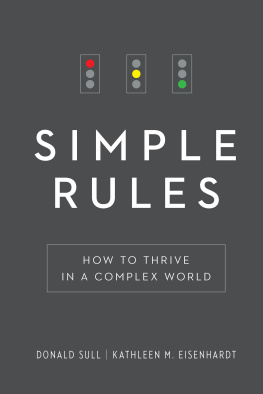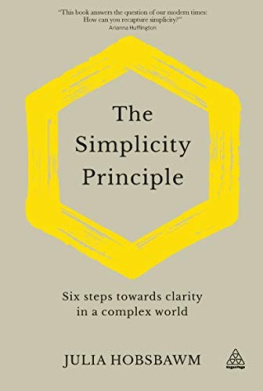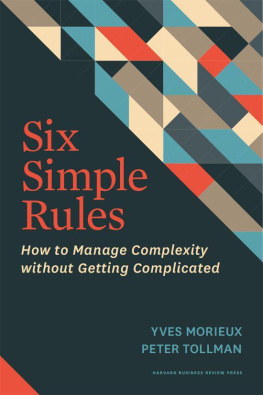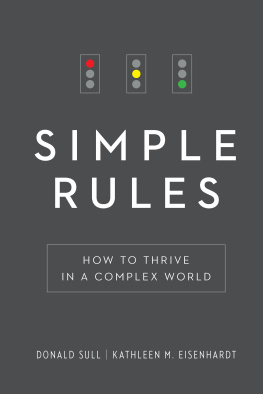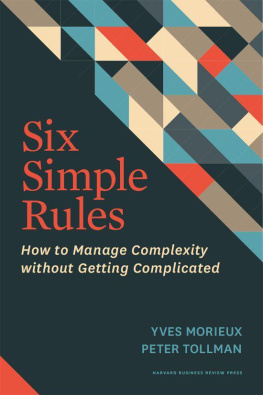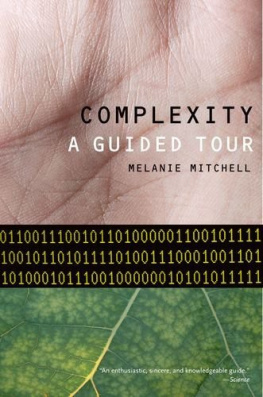Copyright 2015 by Donald Sull and Kathleen M. Eisenhardt
ALL RIGHTS RESERVED
For information about permission to reproduce selections from this book, write to Permissions, Houghton Mifflin Harcourt Publishing Company, 215 Park Avenue South, New York, New York 10003.
www.hmhco.com
Library of Congress Cataloging-in-Publication Data is available.
COVER DESIGN BY FACEOUT STUDIO, EMILY WEIGEL
ISBN 978-0-544-40990-3
e ISBN 978-0-544-40959-0
v1.0415
To our parents, Kathleen and Norman Sull and Marie and Bill Kennedy, with much love and appreciation
Introduction
T HE SIXTY-SEVENTH COMBAT SUPPORT Hospital, located 250 miles northwest of Baghdad, was not like most hospitals. For starters, the doctors carried guns. As officers in the U.S. Army, the physicians were required to wear sidearms, which were deposited in a lockbox before every shift. The hospital often treated Iraqi insurgents, who were known to spit in attending physicians faces as they received treatment. If they (or a disoriented U.S. soldier) got their hands on a weapon, a firefight could break out in the operating room.
Built on the bombed-out remains of a farmers field near the Mosul International Airport, the hospital, a cluster of buildings, trailers, and large green tents, was surrounded by concrete bunkers and blast walls to protect the staff and patients from mortar fire. The medical staff spent days at a time treating routine conditions like indigestion and dehydration (in summer, temperatures in the region could reach 120 Fahrenheit, hot enough to stick the contact lenses to the eyes of soldiers as they walked from one building to another). Lulls could be interrupted at any moment by an onslaught of wounded soldiers and civilians.
At noon on December 21, 2004, at nearby Forward Operating Base Marez, U.S. troops, Iraqi soldiers, and military contractors crowded into the mess tent for lunch. Sergeant Edward Montoya Jr., an Army medic who normally avoided sweets, was feeling homesick at the prospect of Christmas in Iraq and decided to console himself with a piece of cheesecake. As he headed for the dessert table, his buddies ribbed him about putting on weight.
At the same moment, a man wearing an Iraqi security services uniform entered the mess tent, approached a cluster of U.S. soldiers waiting in line for lunch, and detonated an explosive vest concealed under his uniform. Montoya was returning to his seat when he saw a flash out of the corner of his eye, followed by what he remembers as the largest boom in the history of booms. Montoya dove under a table and, as the mess tent filled with smoke, pulled several disoriented soldiers to cover.
After assessing the injuries of a soldier lying next to him, Montoya got to his feet and moved quickly through the tent to evaluate and treat the wounded. One soldier had blood spurting from a femoral artery, and Montoya used his belt to fashion a makeshift tourniquet, securing it around the soldiers leg and applying table napkins to stanch the bleeding. As Montoya moved from soldier to soldier, he checked vital signspulse, responsiveness, blood pressureto gauge the severity of the injuries, using a handful of simple rules to prioritize the injured for care.
The most urgent cases were sent to the Sixty-Seventh Combat Support Hospital. In the span of a few hours, the hospital admitted ninety-one casualties, an influx that overwhelmed its limited resources. Patients pressed up against the hallways to make room for passing medical staff. The less seriously injured had to wait in the parking lot until space freed up indoors. The doctors conducted some of the simpler surgical procedures outside the operating room, and judiciously allocated their dwindling stock of medical supplies. Like Montoya, the hospital staff used a set of rules to sort patients who required immediate care from those who could afford to wait.
Treating traumatic injuries is difficult under the best of circumstances, and combat is about as far from ideal as you can get. The injuries are often severe, the physical conditions bleak; medical staff work under the constant threat of assault, and critical supplies are limited. In 2004 the Army had about fifty surgeons in Iraq to serve 140,000 troops as well as injured civilians and military contractors. Despite the challenges of medical care in wartime, by the beginning of the twenty-first century combat mortality rates had fallen to surprisingly low levels. Only one out of every ten American soldiers injured in Afghanistan and Iraq died of their wounds, well under half the mortality rate of soldiers wounded in Vietnam, and a world away from the 42 percent mortality rate of soldiers wounded in the Revolutionary War. This impressive survival rate is the culmination of continuous improvements in frontline medical care over the past two hundred years. In the grim arms race between medical improvements and ever deadlier weaponry, the doctors are pulling ahead.
Advances in drugs, surgical techniques, and diagnostic equipment are the obvious sources of progress in survival rates. Also important, but less familiar to most people, are improvements in how armies allocate scarce resources in the face of mass casualties. Medical professionals are trained to do whatever they can to help the patient lying in front of them, but frontline medics, medevac pilots, and military doctors must make hard choices about whom to treat first. In the wake of an attack or battle, medics and admitting physicians are forced to make life-and-death decisions about complex injuries, with limited information, under tremendous time pressure, and often under fire.
Throughout most of history, the allocation of medical resources was haphazard. The poet Walt Whitman, who served as a nurse during the U.S. Civil War, observed that the injured were cared for on a first come, first served basis, regardless of the severity of their injuries. The wounded sat in line, waiting patiently for their turn to be seen by a doctor or nurse. After the First Battle of Bull Run, the injured who were able had to walk the thirty-mile distance from the battlefield to hospitals in Washington for treatment, a system that failed those most in need of care, the soldiers lying on the battlefield.
In the Second World War, the U.S. surgeon general introduced a formal process for prioritizing care in order to reduce deaths. The system is known as triage, after the French word for sorting commodities, such as wheat or coffee beans, into categories based on their quality. Given the complexity of the injuries they encounter, you might think medics use complicated algorithms to classify the wounded. They dont. Instead they rely on a handful of simple rules, like those employed by Montoya and the Sixty-Seventh medical staff, to quickly sort injured patients into three or four categories, prioritizing them for treatment. When performing frontline triage, medics will typically spend less than a minute with each patient. Simple guidelines, such as whether the patient can follow instructions, has a pulse rate below 120, or a respiratory rate between ten and thirty breaths per minute, allow medics to quickly evaluate the wounded. The injured are then assigned a color-coded tag that categorizes them according to the severity of their injuries.
Those with stable vital signs are tagged with the color greentreatment can safely be delayed for these walking wounded. At the other extreme, patients who are unlikely to survive even with heroic intervention are tagged with black and provided palliative care. The remaining patients are first in line for care, with the more badly injured given a red priority tag and the others a yellow tag denoting urgent. Sorting the patients using these simple rules ensures that scarce medical resources are brought to bear where they can do the most goodon those patients who have a shot at survival, but only if they receive immediate attention. The rules of triage are widely used to allocate medical resourcessuch as intensive-care-unit beds or vaccines during a flu pandemicin the face of mass casualties. After the Boston Marathon bombings, for example, a first-aid center set up at the finish line was transformed from treating sprained ankles and dehydration to performing rapid-fire triage, prioritizing the wounded for care and directing the most severely injured to nearby hospitals. The rules of triage are an excellent example of what we call
Next page
